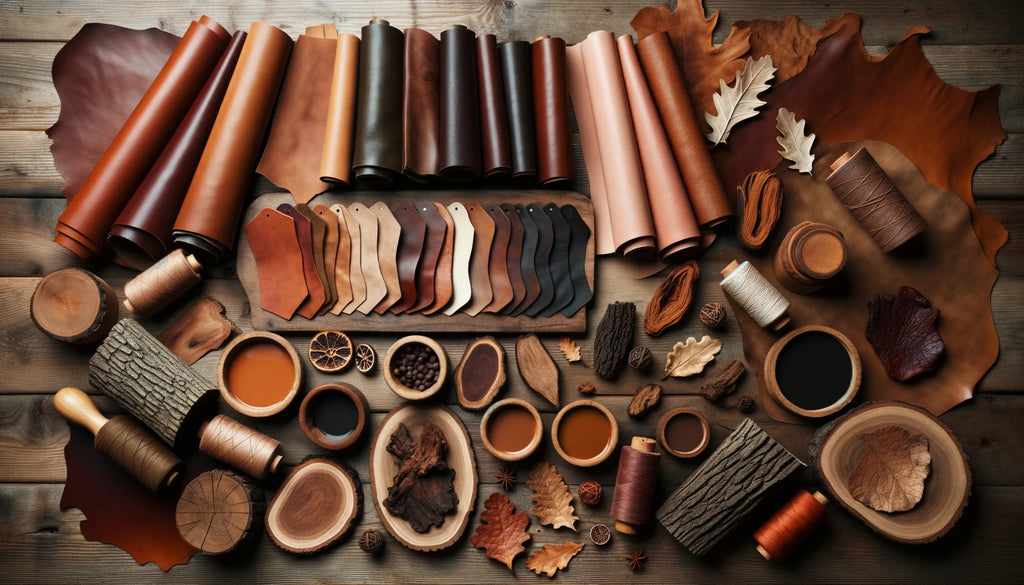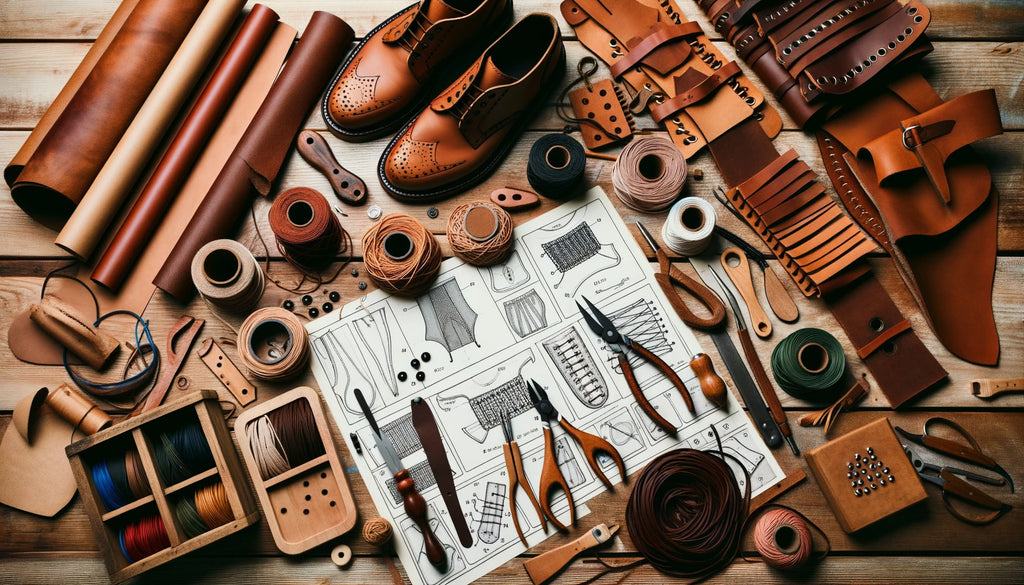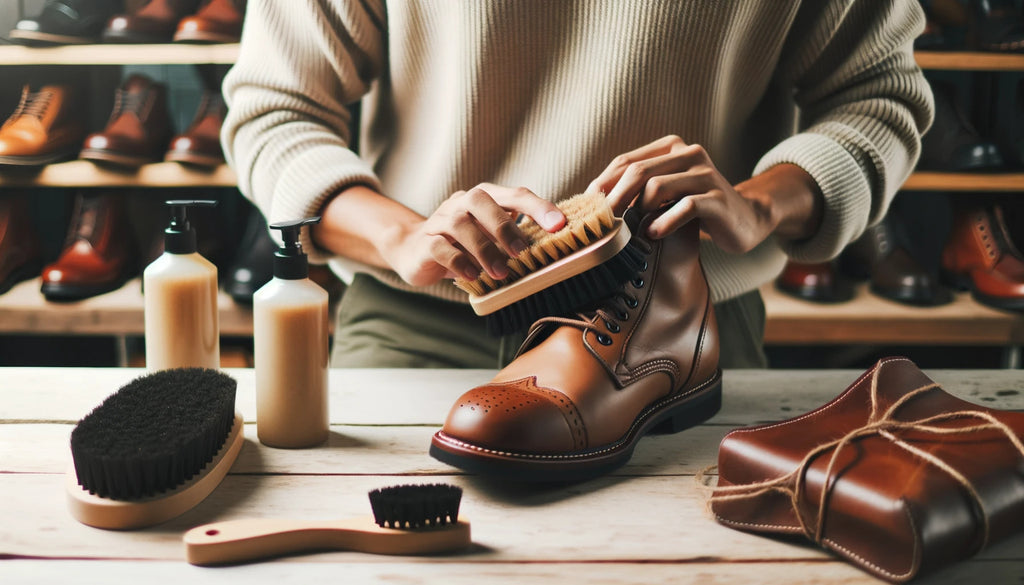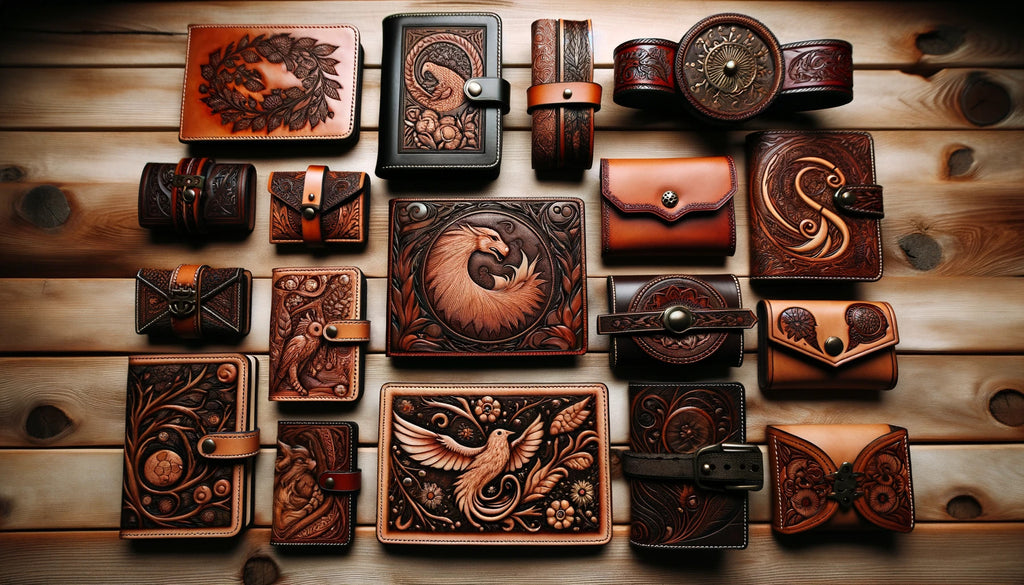
Mastering the Art of Leather Lacing: A Comprehensive Guide
Reading Time: about
In the vast realm of craftsmanship, leather has always held a special place, standing as a testament to time, exuding both elegance and unmatched durability. Beyond its classic and timeless appeal, there's a world of intricate techniques waiting to be explored, with leather lacing shining brightly as the crown jewel.
Dive deep into this mesmerizing art form with us, as we unravel the rich tapestry of leather lacing, tracing its historical roots, understanding its significance, and exploring the myriad techniques that have the power to transform a humble piece of leather into a true masterpiece.
Whether you're a seasoned artisan, a passionate hobbyist, or a curious soul eager to learn, this guide promises a journey filled with discovery, creativity, and a renewed passion for the craft.
Join us, and let's celebrate the art and magic of leather lacing together.
I. Understanding Leather Lacing
Leather lacing, a timeless technique, has been a cornerstone of leather craftsmanship for centuries. As we delve into this intricate world, it's essential to grasp its basics and the types of leather best suited for it.
1. What is Leather Lacing?
When I first embarked on my leatherworking journey, leather lacing was one of the techniques that truly fascinated me. At its core, leather lacing is the art of binding or decorating leather pieces using thin strips or cords of leather. It's not just about joining two pieces together; it's about adding a touch of elegance and strength to the finished product.
Now, you might wonder how leather lacing differs from other leatherworking techniques. While there are numerous methods to work with leather, such as stitching or riveting, lacing stands out due to its unique aesthetic appeal and the flexibility it offers in design. It's a technique that seamlessly marries functionality with artistry.
2. Types of Leather Suitable for Lacing
Selecting the right type of leather is paramount. Not all leathers are created equal, and the choice can significantly impact the outcome of your lacing project.
-
Full-grain vs. Top-grain
When we talk about the cream of the crop in leather quality, full-grain takes the crown. It's the most authentic form, retaining the natural grain pattern. I've found that its durability and strength make it ideal for lacing. On the other hand, top-grain leather, while still of high quality, has its surface sanded and refinished. This process makes it smoother, but it might not offer the same rugged authenticity as full-grain.
-
Vegetable-tanned vs. Chrome-tanned
The tanning process can define the leather's character. Vegetable-tanned leather, tanned using tannins from plants and bark, offers a more natural and earthy look. It's my go-to for projects where I want the leather to develop a patina over time. Chrome-tanned leather, processed with chemicals, is more pliable and comes in a wider range of colors. However, it might not be the best fit for traditional lacing projects.
-
Factors Affecting the Choice of Leather
Several considerations come into play when choosing leather for lacing. Think about the project's purpose, the desired aesthetic, and the leather's thickness and flexibility. Remember, the goal is to make an informed choice that aligns with your vision.
Understanding leather lacing and the types of leather suitable for it is crucial for anyone passionate about leather craftsmanship. As we've explored, the choices we make in terms of technique and material can profoundly influence the final product. So, whether you're a seasoned leatherworker or just starting, always prioritize knowledge and quality in your craft.

II. Tools and Materials for Leather Lacing
When diving into the world of leather lacing, having the right tools and materials at your disposal is paramount. Not only do they ensure precision, but they also make the process more enjoyable. I've delved deep into the essentials to provide you with a comprehensive guide on what you'll need.
1. Essential Tools for Lacing
Lacing Needles
At the heart of leather lacing is the humble lacing needle. It's the bridge that connects your lace to the leather, allowing for intricate designs and patterns. Opt for a sturdy needle, preferably one designed specifically for leatherwork. It'll make threading easier and ensure durability.
Lacing Chisels and Punches
When we talk about creating those perfect holes in leather, lacing chisels and punches come into play. These tools are indispensable for achieving uniform and clean holes. Remember, the quality of your holes can make or break your lacing design.
Cutting Tool
A sharp cutting tool is essential for trimming laces or cutting leather pieces to size. Whether you're using scissors or a specialized leather cutter, ensure it's sharp and well-maintained. A clean cut can significantly elevate the final look of your project.
2. Choosing the Right Lace
Width and Thickness Considerations
The lace's width and thickness play a pivotal role in the final appearance of your laced leather item. Consider the project at hand. For intricate designs, you might want a thinner lace, while broader laces can offer a bold and robust look.
Material Options
When it comes to lace materials, you're spoiled for choice. While cowhide is a popular and versatile option, kangaroo laces are known for their strength and elasticity. For those looking for alternatives, synthetic laces can be a viable option, especially for projects that demand water resistance or specific colors.
3. Preparing Leather for Lacing
Cleaning and Conditioning
Before you even think of lacing, ensure your leather piece is clean and conditioned. Dirt or grime can interfere with the lacing process. Conditioning the leather not only makes it supple but also ensures longevity. Think of it as prepping a canvas before painting.
Marking and Punching Holes
Precision is key here. Before punching holes, it's wise to mark them out. This ensures uniformity and can save you from potential mishaps. Once marked, use your lacing chisel or punch to create the holes. Take your time, and remember: accuracy over speed.
Leather lacing is as much about the journey as it is about the final product. With the right tools and materials, coupled with patience and practice, you're well on your way to creating masterpieces. Whether you're a seasoned leatherworker or just starting, always remember to enjoy the process. After all, it's the love and care we infuse into our crafts that truly make them stand out.

III. Techniques and Patterns in Leather Lacing
Leather lacing is an art form that has been practiced for centuries. The intricate designs and patterns created through this technique can transform a simple leather piece into a work of art. As someone who has delved deep into the world of leatherwork, I'd like to share some insights into the techniques and patterns that can elevate your leather lacing game.
1. Basic Lacing Techniques
When starting out, it's essential to master the foundational techniques. These are the building blocks that will set the stage for more advanced patterns.
Single Loop
The single loop is the most basic form of leather lacing. It involves threading the lace through a series of evenly spaced holes, creating a simple and clean look. This technique is perfect for beginners and can be used in a variety of projects, from bracelets to belts.
Double Loop
As the name suggests, the double loop involves threading the lace through each hole twice. This creates a denser and more intricate pattern compared to the single loop. It's a versatile technique that adds a touch of sophistication to any leather piece.
Whipstitch
The whipstitch is a classic lacing method that wraps the lace over the edge of the leather, creating a decorative border. It's a great way to add a finished look to your projects and provides additional strength to the edges.
2. Advanced Lacing Patterns
Once you've mastered the basics, it's time to explore some advanced lacing patterns. These techniques can add depth, texture, and visual interest to your leatherwork.
Spanish Edge Lacing
Drawing inspiration from traditional Spanish leatherwork, this technique involves weaving the lace in a specific pattern to create a decorative edge. It's a bit more complex but results in a stunning, eye-catching design.
Two-tone Spiral Lacing
This technique uses two different colored laces to create a spiral pattern. The contrasting colors intertwine, producing a dynamic and vibrant design. It's a fantastic way to add a pop of color to your leather pieces.
Cross-over Lacing
Cross-over lacing creates a crisscross pattern, adding depth and texture to the leather. It's a versatile technique that can be used in both functional and decorative projects.
3. Tips for Achieving a Clean Finish
Achieving a clean finish is crucial in leather lacing. It's the difference between a project that looks amateurish and one that looks professionally crafted.
Maintaining Even Tension
Consistency is key. Ensure that you maintain even tension throughout your lacing to prevent any loose or overly tight sections. This not only improves the appearance but also the durability of your piece.
Securing Ends and Hiding Knots
To give your project a polished look, it's essential to securely fasten the ends and hide any knots. This can be done by threading the lace back through the last few holes and tying it off on the underside.
Troubleshooting Common Issues
Mistakes happen, but they can often be fixed. If you notice any inconsistencies or errors in your lacing, take a moment to assess and correct them. Whether it's adjusting the tension or re-lacing a section, a little attention to detail can make a world of difference.
Leather lacing is a skill that requires patience, practice, and a keen eye for detail. Whether you're a beginner or a seasoned pro, there's always something new to learn and explore in this craft. By mastering the techniques and patterns I've shared, you'll be well on your way to creating leather pieces that are not only beautiful but also functional and durable. Remember, the key is to keep practicing, stay curious, and most importantly, enjoy the journey.

IV. Diving into the Applications of Leather Lacing
1. Fashion and Accessories: More Than Just a Style Statement
When I think of leather lacing in the realm of fashion, it's not just about aesthetics; it's about crafting a narrative. Let's explore some of its applications:
- Belts and Bracelets: Beyond their functional role, these accessories have evolved into fashion statements. Laced leather belts, for instance, aren't just about holding your pants up; they're about adding a touch of rustic elegance to your ensemble. Similarly, leather-laced bracelets, often adorned with intricate patterns, tell a story of craftsmanship and style.
- Handbags and Wallets: We all know the importance of a good handbag or wallet. It's not just a storage solution; it's an extension of our personality. Incorporating leather lacing into these items adds a touch of uniqueness, making them stand out in a sea of mass-produced alternatives.
- Footwear Detailing: Ever noticed those intricate laced patterns on boots or sandals? That's leather lacing at work. It's not just for aesthetics; it often adds structural integrity to the footwear, ensuring they last longer while looking fabulous.
2. Home Decor and Utility Items: Blending Functionality with Aesthetics
Leather lacing isn't limited to just fashion. When we delve into home decor and utility items, its applications are both surprising and impressive:
- Leather-bound Books: There's something timeless about leather-bound books. They exude a sense of history and luxury. The addition of leather lacing elevates their appeal, making them not just books, but pieces of art. As a reader, holding a leather-laced book feels like holding a piece of history.
- Furniture and Upholstery: Imagine a leather couch with intricate lacing or a chair with laced armrests. These aren't just pieces of furniture; they're conversation starters. The lacing adds a touch of sophistication, making them more than just functional items.
- Tool Handles and Sheaths: For those of us who appreciate the finer details, leather-laced tool handles and sheaths are a delight. Not only do they offer a better grip, but they also make these everyday items look like they belong in a craftsman's workshop.
Leather lacing, with its myriad applications, is a testament to the blend of functionality and aesthetics. Whether you're looking to make a fashion statement or elevate your home decor, leather lacing is a choice that marries tradition with modernity. As we explore its applications, it's evident that this art form, rooted in history, has a significant place in our contemporary world.

V. Caring for Laced Leather Items
When it comes to preserving the beauty and functionality of our leather items, especially those adorned with intricate lacing, proper care is paramount. I've delved deep into the best practices and want to share with you some insights that can make a difference in the longevity of your cherished leather pieces.
1. Cleaning and Maintenance
Safe Cleaning Agents for Laced Leather
Before diving into the cleaning process, it's essential to choose the right cleaning agents. Not all cleaners are suitable for leather, especially when it's laced. I recommend opting for gentle, pH-balanced leather cleaners. These agents are specifically formulated to cleanse without stripping the leather of its natural oils. Remember, harsh chemicals or abrasive materials can damage the delicate lacing and the leather's surface.
Conditioning to Maintain Flexibility
After cleaning, the next step is conditioning. Leather, like our skin, can dry out and lose its flexibility over time. To combat this, it's crucial to use a high-quality leather conditioner. This not only restores moisture but also ensures that both the leather and the lacing remain supple. When I condition my leather items, I make sure to apply the product evenly, allowing it to penetrate the leather's pores, ensuring it remains soft and pliable.
2. Repair and Restoration
Re-lacing Damaged Sections
Accidents happen, and sometimes our beloved leather items can suffer from wear and tear. If you notice any damaged or frayed lacing, don't despair. With the right tools and techniques, re-lacing can breathe new life into your item. We can carefully remove the damaged section and replace it with a new lace that matches the original in color and texture.
Replacing Worn-Out Laces
Over time, laces, especially those on frequently used items, can wear out. Instead of discarding the entire piece, consider simply replacing the laces. It's a cost-effective solution that can extend the life of your leather item significantly.
Preserving the Longevity of Laced Items
To ensure your laced leather items stand the test of time, it's vital to store them properly. Keep them away from direct sunlight, which can cause fading, and in a cool, dry place. Regular maintenance, combined with prompt repairs, can ensure that your leather treasures remain in pristine condition for years to come.
The care and maintenance of laced leather items might seem daunting at first, but with the right knowledge and tools, it becomes a straightforward task. By following the guidelines I've shared, you can ensure that your leather items remain as stunning and functional as the day you acquired them. Remember, it's not just about preserving a material; it's about cherishing the memories and experiences associated with it.

VI. Leather Crafting Techniques Relevant to Lacing
When diving into the world of leather crafting, it's essential to understand the various techniques that can elevate your creations. Lacing is just one aspect of this intricate craft. Let's delve deeper into some of the techniques that often go hand-in-hand with leather lacing.
1. Leather Dyeing
When I think about giving life to a piece of leather, dyeing is often the first thing that comes to mind. It's the application of pigments that add vibrancy and character to your leather pieces. But did you know there are different mediums for this?
- Oil-Based Dyes: These provide a rich and deep color, ensuring the leather retains its natural feel.
- Alcohol-Based Dyes: They penetrate the leather more deeply but might dry it out a bit.
- Water-Based Dyes: Eco-friendly and less pungent, but sometimes they might not offer the same depth of color.
2. Leather Painting
Now, painting on leather is an art in itself. Unlike dyeing, which seeps into the leather, painting remains on the surface. Here's what you should know:
- Surface Application: Paints stay on the top layer, adding a visual appeal without altering the leather's inherent characteristics.
- Suitable Items: Think of items that won't bend too much, like wall hangings or book covers. Bending can cause the paint to crack.
3. Leather Carving and Tooling
Carving leather is like sculpting clay. It's all about creating designs that pop out, giving a three-dimensional effect. Here's a glimpse into this technique:
- Tools of the Trade: The swivel knife, veiner, and beveler are your best friends here. Each has a unique role in etching designs onto the leather.
- Sheridan Style: A popular style in the U.S. and Mexico, it's characterized by intricate floral patterns, often reminiscent of roses.

4. Stamping and Embossing
Ever seen those beautiful imprints on leather? That's the magic of stamping and embossing.
- Creating Imprints: Using specially designed stamps, you can press patterns onto the leather's surface.
- Commercial Stamps: These come in various designs, from geometric patterns to animal motifs. The choice is vast, catering to every artisan's preference.
5. Molding and Shaping
Molding leather is like pottery. You shape and mold it when it's wet, and as it dries, it retains that shape.
- The Process: Soak the leather to make it pliable, then shape it using hands or molds.
- Applications: From fantasy-inspired armor to classic handbags, molding finds its place in various creations.
6. Laser Cutting and Etching
Incorporating technology into leather crafting, lasers offer precision like no other.
- Detailed Designs: Lasers can etch intricate patterns, ensuring every detail is captured perfectly.
7. Perforation and Pyrography
Last but not least, these techniques add the finishing touches to your leather pieces.
- Perforation: Think of it as creating a patterned series of holes in the leather, adding a decorative touch.
- Pyrography: It's the art of burning designs onto the leather. The result? A rustic, vintage look that's truly captivating.
Leather crafting is a vast field with numerous techniques to explore. Whether you're a beginner or a seasoned artisan, there's always something new to learn and master. Remember, the key is to practice, experiment, and most importantly, enjoy the process. After all, it's not just about the final product but the journey of creation.

Conclusion
Leather crafting, with its myriad techniques and styles, is more than just a skill—it's an art form that bridges the gap between tradition and innovation. As we've journeyed through the various facets of this craft, from dyeing to pyrography, it's evident that each technique offers a unique touch, transforming a simple piece of leather into a masterpiece.
Whether you're an enthusiast looking to dive into this world or a seasoned artisan, remember that every stitch, cut, and imprint tells a story. Embrace the learning curve, cherish the imperfections, and let your creations be a testament to your passion and dedication. In the realm of leather crafting, the possibilities are as boundless as your imagination.
Frequently Asked Questions
What exactly is leather lacing?
Leather lacing is a technique where thin strips of leather, known as laces, are used to bind two pieces of leather together, often in decorative patterns or designs.
Is leather lacing durable?
Absolutely! When done correctly, leather lacing can be incredibly durable, often outlasting other methods of joining leather, like stitching.
Can I use any leather for lacing?
While you can technically use any leather, vegetable-tanned leather is often preferred due to its durability and ease of working.
Are there different styles of leather lacing?
Yes, there are various styles and techniques, such as the whipstitch, double loop, and Spanish edge lacing, each offering a unique look.
Do I need special tools for leather lacing?
Basic tools include lacing needles and a good pair of scissors. For more intricate designs, you might need punches or chisels.
How do I ensure my lacing remains tight and doesn't come undone?
Consistent tension is key. Also, securing the ends with a knot or incorporating them into the design ensures the lacing remains intact.
Can I combine leather lacing with other leather crafting techniques?
Definitely! Lacing can be combined with carving, stamping, dyeing, and more to create intricate and unique designs.
Is leather lacing only for decorative purposes?
While lacing is often used for its decorative appeal, it's also a functional method of joining leather pieces together, especially in items like belts, wallets, and bags.
How do I care for laced leather items?
Regularly clean and condition the leather. Avoid soaking it in water, as this might loosen the lacing. If the lacing does become loose over time, it can be re-tightened or replaced.
Where can I learn leather lacing?
Many local craft stores offer workshops. Additionally, there are numerous online tutorials and books dedicated to leather lacing techniques.
📫 Related Blog Posts:
📌 How to Restore Leather? A Complete Guide to Revive Your Leather
📌 How to Darken Leather? From Faded to Fabulous
📌 7 Leather Crafting Secrets From The Pros Unveiled
📌 Best Leather Anniversary Gifts: Celebrate Love with Timeless Elegance
📌 How to Stiffen Leather Like a Pro? From Supple to Sturdy
📌 DIY Leather Conditioners: Nature's Touch for Timeless Elegance
1 comment





tutoriel tres interressant et tres bien presente et concu.a mon humble avis il serait parfait si ilincluait quelques exemples de points de lacage.merci pour cette presentation
Leave a comment